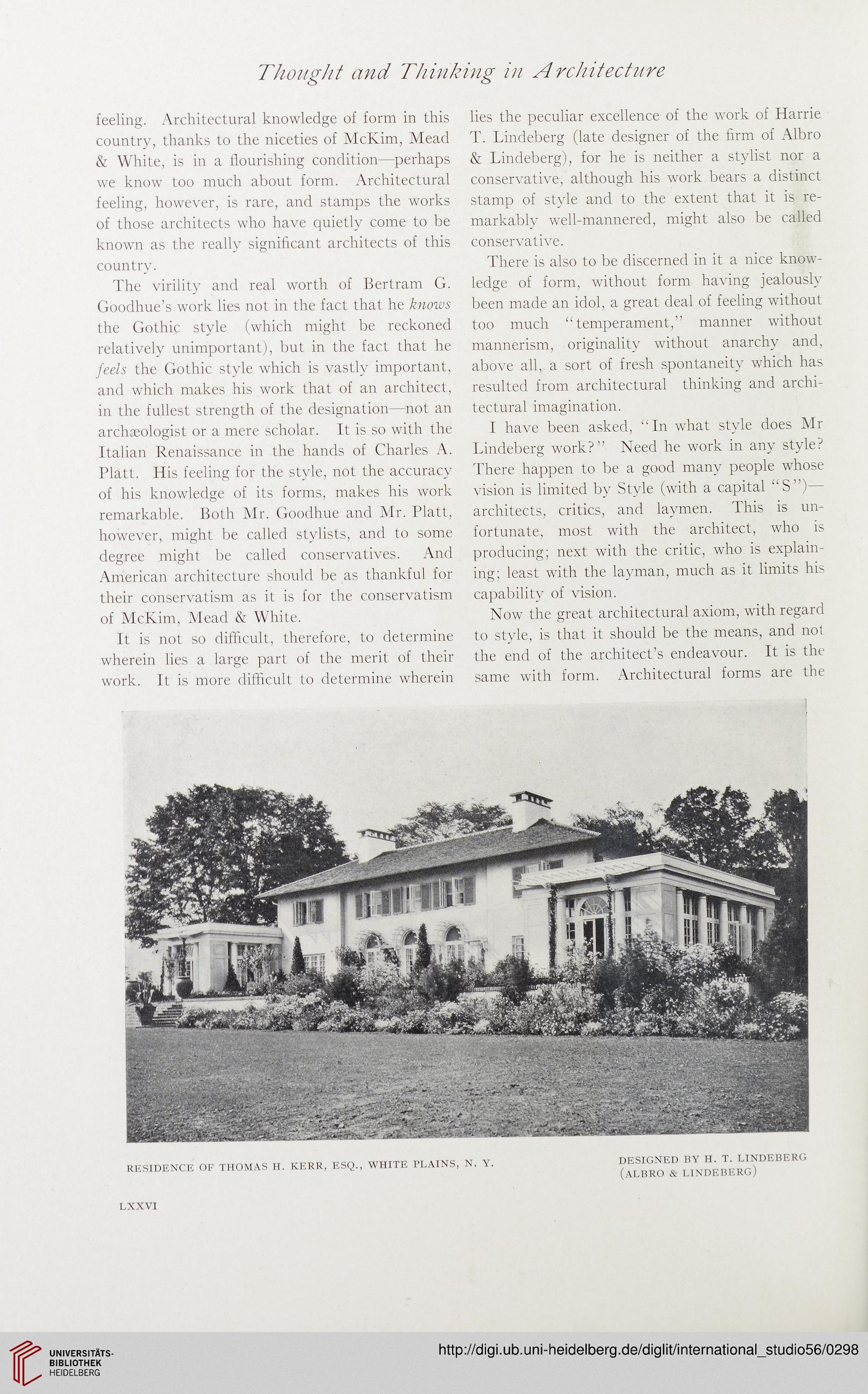Thought and Thinking in Architecture
feeling. Architectural knowledge of form in this
country, thanks to the niceties of McKim, Mead
& White, is in a flourishing condition—perhaps
we know too much about form. Architectural
feeling, however, is rare, and stamps the works
of those architects who have quietly come to be
known as the really significant architects of this
country.
The virility and real worth of Bertram G.
Goodhue’s work lies not in the fact that he knows
the Gothic style (which might be reckoned
relatively unimportant), but in the fact that he
feels the Gothic style which is vastly important,
and which makes his work that of an architect,
in the fullest strength of the designation—not an
archaeologist or a mere scholar. It is so with the
Italian Renaissance in the hands of Charles A.
Platt. His feeling for the style, not the accuracy
of his knowledge of its forms, makes his work
remarkable. Both Mr. Goodhue and Mr. Platt,
however, might be called stylists, and to some
degree might be called conservatives. And
American architecture should be as thankful for
their conservatism as it is for the conservatism
of McKim, Mead & White.
It is not so difficult, therefore, to determine
wherein lies a large part of the merit of their
work. It is more difficult to determine wherein
lies the peculiar excellence of the work of Harrie
T. Lincleberg (late designer of the firm of Albro
& Lindeberg), for he is neither a stylist nor a
conservative, although his work bears a distinct
stamp of style and to the extent that it is re-
markably well-mannered, might also be called
conservative.
There is also to be discerned in it a nice know-
ledge of form, without form having jealously
been made an idol, a great deal of feeling without
too much “temperament,” manner without
mannerism, originality without anarchy and,
above all, a sort of fresh spontaneity which has
resulted from architectural thinking and archi-
tectural imagination.
I have been asked, “In what style does Mr
Lindeberg work?” Need he work in any style?
There happen to be a good many people whose
vision is limited by Style (with a capital “S”)—
architects, critics, and laymen. This is un-
fortunate, most with the architect, who is
producing; next with the critic, who is explain-
ing; least with the layman, much as it limits his
capability of vision.
Now the great architectural axiom, with regard
to style, is that it should be the means, and not
the end of the architect’s endeavour. It is the
same with form. Architectural forms are the
RESIDENCE OF THOMAS H. KERR, ESQ., WHITE PLAINS, N. Y.
DESIGNED BY H. T. LINDEBERG
(ALBRO & LINDEBERG)
LXXVI
feeling. Architectural knowledge of form in this
country, thanks to the niceties of McKim, Mead
& White, is in a flourishing condition—perhaps
we know too much about form. Architectural
feeling, however, is rare, and stamps the works
of those architects who have quietly come to be
known as the really significant architects of this
country.
The virility and real worth of Bertram G.
Goodhue’s work lies not in the fact that he knows
the Gothic style (which might be reckoned
relatively unimportant), but in the fact that he
feels the Gothic style which is vastly important,
and which makes his work that of an architect,
in the fullest strength of the designation—not an
archaeologist or a mere scholar. It is so with the
Italian Renaissance in the hands of Charles A.
Platt. His feeling for the style, not the accuracy
of his knowledge of its forms, makes his work
remarkable. Both Mr. Goodhue and Mr. Platt,
however, might be called stylists, and to some
degree might be called conservatives. And
American architecture should be as thankful for
their conservatism as it is for the conservatism
of McKim, Mead & White.
It is not so difficult, therefore, to determine
wherein lies a large part of the merit of their
work. It is more difficult to determine wherein
lies the peculiar excellence of the work of Harrie
T. Lincleberg (late designer of the firm of Albro
& Lindeberg), for he is neither a stylist nor a
conservative, although his work bears a distinct
stamp of style and to the extent that it is re-
markably well-mannered, might also be called
conservative.
There is also to be discerned in it a nice know-
ledge of form, without form having jealously
been made an idol, a great deal of feeling without
too much “temperament,” manner without
mannerism, originality without anarchy and,
above all, a sort of fresh spontaneity which has
resulted from architectural thinking and archi-
tectural imagination.
I have been asked, “In what style does Mr
Lindeberg work?” Need he work in any style?
There happen to be a good many people whose
vision is limited by Style (with a capital “S”)—
architects, critics, and laymen. This is un-
fortunate, most with the architect, who is
producing; next with the critic, who is explain-
ing; least with the layman, much as it limits his
capability of vision.
Now the great architectural axiom, with regard
to style, is that it should be the means, and not
the end of the architect’s endeavour. It is the
same with form. Architectural forms are the
RESIDENCE OF THOMAS H. KERR, ESQ., WHITE PLAINS, N. Y.
DESIGNED BY H. T. LINDEBERG
(ALBRO & LINDEBERG)
LXXVI




